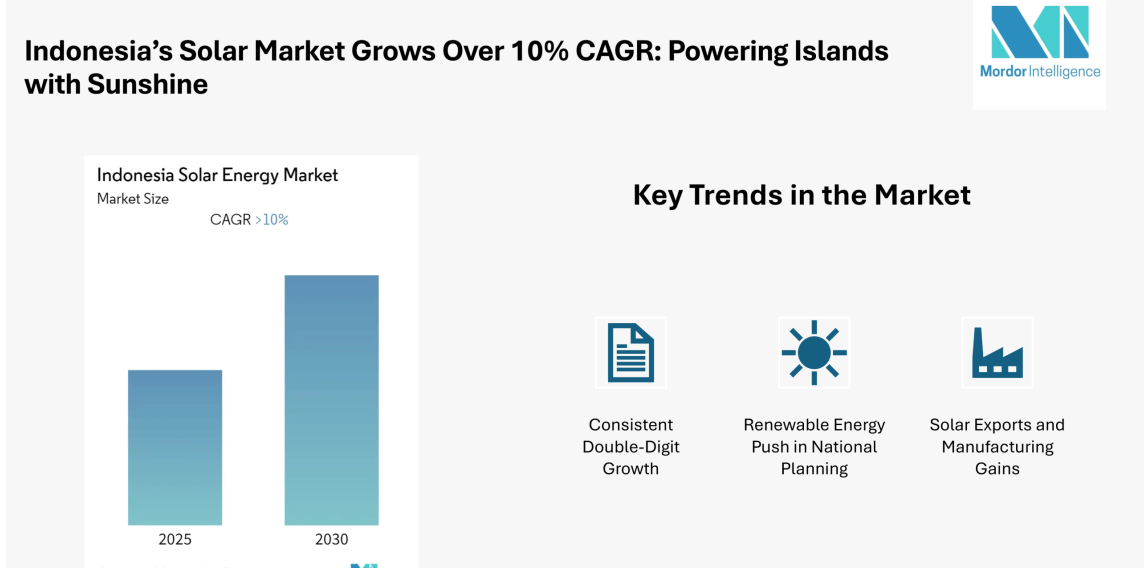Mordor Intelligence’s new study on the “Indonesia Solar Energy Market” presents a thorough evaluation of the market's trajectory, including major trends and outlook.
Introduction
The Indonesia Solar Energy Market reached approximately 532.4 GWh of generation capacity in 2024, according to recent industry estimates. With growing interest from businesses, regulators, and rural communities, the market is expected to expand steadily at a compound annual growth rate of over 10 percent between 2025 and 2030
Indonesia’s archipelagic geography presents unique challenges in electrification-many remote islands remain off-grid. Solar stands out as a sustainable solution to bridge those gaps. Government policies and investment trends are now aligning to support both on‑grid and off‑grid solar deployments across the country.
Indonesia Solar Energy Market Key Trends
- Consistent Double‑Digit Growth
The market is projected to grow at a CAGR higher than 10 percent through 2030. This momentum reflects rising installations across rooftops, utility‑scale farms, and off‑grid applications. - Renewable Energy Push in National Planning
Indonesia aims to increase its renewable share from around 12 percent in 2024 to about 35 percent by 2034, with solar slated to deliver nearly 17 GW of that expansion under the latest RUPTL plan . This shift reinforces solar’s role in the national energy mix. - Solar Exports and Manufacturing Gains
Following recent tariffs on solar imports into the U.S., firms have relocated production to Indonesia. Its share of solar module exports to the U.S. soared from under 1 percent in 2023 to nearly 29 percent in late 2024, leveraging tariff‑avoiding strategies - Off‑Grid Solar Growth Driven by Electrification Goals
Remote and underserved areas are making up significant demand for off‑grid systems. With many islands lacking grid access, solar lanterns, small home‑systems and microgrids are gaining ground, backed by rural electrification initiatives. - Technology as an Enabler, Not a Focus of Policy
Falling module costs and better financing make solar more economically attractive. While technology progress helps, policy consistency and incentives drive the majority of deployment rather than cutting‑edge innovation.
Indonesia Solar Energy Market Segmentation
The market can be broken down by connection type, with distinct growth drivers in each category:
By Connection Type
- On‑Grid Solar (Utility‑scale and Rooftop)
- Utility‑scale solar farms serve larger regions and commercial users.
- Rooftop installations in industrial parks, businesses, and homes are increasing, often backed by net‑billing or similar schemes.
- These segments benefit from improved grid infrastructure and private sector financing.
- Off‑Grid Solar
- Includes stand‑alone modules, lanterns and micro‑systems suited for remote or island communities.
- Growth stems from efforts to raise the national electrification ratio and reduce reliance on diesel or kerosene.
Other Notable Segmentation Factors
- End User
- Commercial and industrial solar rooftop demand is expanding at a CAGR of about 22 percent, attributed to energy cost concerns and corporate sustainability goals
- Utility‑scale capacity constitutes over 60 percent of renewable installations as of 2024
- Renewable Source Mix
- Solar PV is the fastest-growing segment within Indonesia’s broader renewable energy market, targeting 24 percent CAGR through 2030, though hydropower still represents over half of installed renewable capacity currently.
Indonesia Solar Energy Market Key Players
The Indonesian solar sector is moderately fragmented, with several domestic and international firms engaged in project development, manufacturing, and EPC services
Prominent companies Include:
- PT Sumber Energi Sukses Makmur
- PT Solardex Energy Indonesia
- Canadian Solar Inc. (global player)
- PT Sumber Energi Surya Nusantara
- PT Surya Utama Nuansa
These companies are pursuing different strategies including solar project development, local manufacturing partnerships, and rooftop system installations. Firms like Trina Solar and TotalEnergies operate in Indonesia through strategic collaboration and contract projects
At Mordor Intelligence, we go beyond presenting numbers - we deliver intelligence that reveals the evolving dynamics, disruptive technologies, and policy frameworks reshaping global industries. Our insights empower leaders to anticipate challenges, identify opportunities, and make informed decisions with confidence.
Our indonesia solar energy market study provides more than market figures - it offers a holistic perspective on technological advancements, strategic partnerships, and regulatory shifts driving the sector. With this depth of analysis, organizations can capitalize on growth opportunities, navigate disruption, and accelerate their transition toward a sustainable energy future.
Indonesia Solar Energy Market Conclusion
Growth drivers include government targets for renewables, shifting global supply dynamics-especially in solar manufacturing-and rising demand in off-grid and rooftop segments. Although hydropower remains dominant today, solar PV is the fastest-growing renewable technology in Indonesia.




